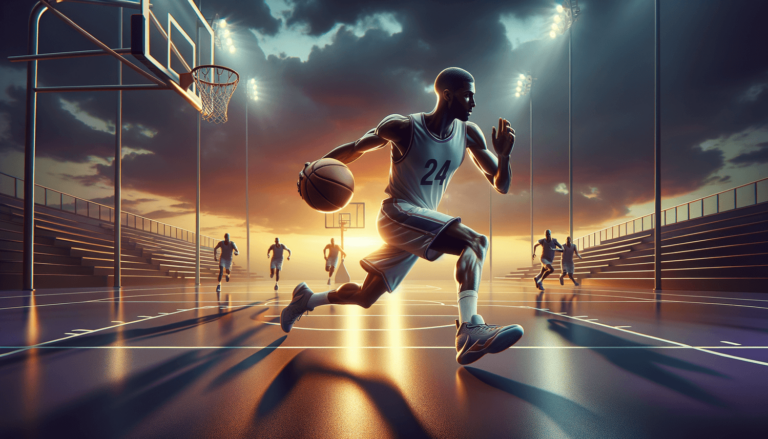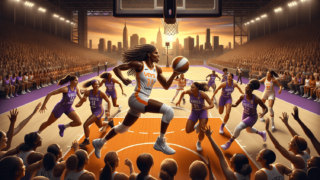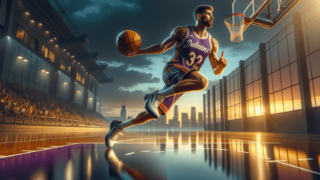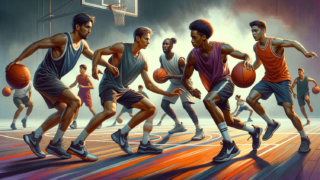
What’s a Behind-the-Back Dribble in Basketball?
Written by: Basketball Universe
Last updated:

Welcome to the world of basketball, where creative flair and skill often mesh to produce spectacular plays on the court. Today, we’ll dive deep into one such awe-inspiring move—the behind-the-back dribble. This nifty technique showcases not only a player’s agility but also their ability to outmaneuver opponents with style. Designed to dazzle fans and leave defenders scratching their heads, the behind-the-back dribble has become an integral part of the game’s artistry. So, get ready to delve into the fascinating mechanics, history, and significance of this remarkable dribbling skill in the world of basketball.
What’s a Behind-the-Back Dribble in Basketball?
A behind-the-back dribble is a basketball move where a player dribbles the ball behind their back, switching it from one hand to the other while maintaining control. This technique helps the player to shield the ball from defenders, change directions quickly, and add an element of surprise during the game.
History of the Behind-the-Back Dribble in Basketball
The behind-the-back dribble has been a part of basketball’s rich history and evolution for many decades. As players’ skills continued to develop, and the game became more strategic, athletes experimented with different dribbling techniques to gain an edge over their opponents.
A player named Bob Cousy, who played in the NBA from 1950-1970, is often credited with popularizing the behind-the-back dribble. Known for his exceptional ball-handling skills, Cousy frequently used this move to keep the ball away from his defender and create scoring opportunities for his teammates.
Anatomy of a Perfect Behind-the-Back Dribble: The Mechanics
Getting into Position
To execute a flawless behind-the-back dribble, you need to start from the correct position. The first step is to assume a low stance, bending your knees slightly and keeping the feet shoulder-width apart. This stance enables better control over the ball and makes it easier to change directions when required.
Starting the Dribble
Initiate the dribble by bouncing the ball to your side, slightly away from your body. Make sure to use a strong, forceful push using your fingers rather than slapping the ball with a flat hand. This will help to control the pace and direction of the dribble more effectively.
Moving the Ball Behind the Back
As the ball reaches its peak height during the bounce, extend the arm that was used to dribble and reach across your back. At this point, the ball should be behind you, with the hand initiating the dribble now parallel to the opposite hip. The other hand should be ready to receive the ball.
Transferring the Ball
In a smooth sweeping motion, guide the ball from one hand to the other by sliding your initial dribbling hand further across your back, while your other hand takes control of the ball. During this process, ensure that the ball doesn’t bounce too high or too low, as it might make the transfer difficult and allow defenders an opportunity to steal the ball.
Completing the Dribble
Once the ball has been transferred to the other hand, continue dribbling as you would with a regular move. You should now be in a position to change direction or make your next move, depending on your strategy and the actions of your defenders.
How the Behind-the-Back Dribble Benefits Your Game
Enhancing Ball Control
Like most advanced dribbling techniques, the behind-the-back dribble improves a player’s overall ball control. With enough practice, you’ll develop the ability to change your dribble from one hand to the other quickly and efficiently, even in tight situations. The increased control also means defenders will have a harder time stealing the ball from you.
Adding Unpredictability
The behind-the-back dribble is an unpredictable move that leaves defenders guessing which way you might go. When you’re able to execute this move effectively, you can keep your opponents on their toes, making them more likely to commit fouls or allow easier scoring opportunities for your team.
Improving Change of Direction
The ability to change direction swiftly is a vital skill in basketball. Incorporating the behind-the-back dribble into your game can help you achieve this. By going behind your back, you can confuse defenders and initiate a sudden change of direction, making it easier for you to penetrate defenses and set up scoring opportunities.
Boosting Confidence and Style Points
Let’s be honest, when done correctly, the behind-the-back dribble is simply fun and stylish. Executing this move impeccably, especially during a game, can boost your confidence and impress your teammates and fans alike. It’s a strong statement about your basketball skills and ball-handling abilities.
Drills to Improve Your Behind-the-Back Dribble
Stationary Behind-the-Back Dribble Drill
This drill involves staying in one place and repeatedly performing the behind-the-back dribble. Start with a regular dribble and transfer the ball behind your back. Repeat the process, alternating hands with each repetition. This drill is perfect for getting comfortable with the motion and improving your hand-eye coordination.
Full-Court Z-Dribble Drill
The Full-Court Z-Dribble Drill is an advanced technique that combines behind-the-back dribbling with other dribbling moves. Begin at one baseline and dribble forward using regular dribbles. After a few steps, perform a behind-the-back dribble while changing direction at a 45-degree angle. Alternate between regular dribbling and behind-the-back dribbling until you reach the other baseline.
Two-Ball Behind-the-Back Dribble Drill
This advanced drill aims to further enhance your dribbling proficiency. Start with two basketballs, one in each hand. Begin dribbling with both hands simultaneously, and after a few bounces, execute a behind-the-back dribble with one hand while continuing to dribble with the other. Once the transfer is complete, repeat the process with the other hand. This drill will help you develop better ball control and ambidexterity.
Notable NBA Players Who Mastered the Behind-the-Back Dribble
Earvin “Magic” Johnson
One of the most talented point guards in NBA history, Magic Johnson, was known for his extraordinary ball-handling skills. He frequently utilized the behind-the-back dribble to make stunning passes and lead fast breaks, earning him the nickname “Magic.”
Isiah Thomas
Isiah Thomas, another legendary point guard, often used the behind-the-back dribble to deceive defenders and create opportunities for his teammates. His exceptional skills and basketball IQ enabled him to successfully execute this move in high-pressure situations.
Allen Iverson
Allen Iverson, dubbed “The Answer,” was a gifted scorer and prolific ball handler who frequently employed the behind-the-back dribble. He used this skill to weave through defenders, setting up his iconic crossover move and leaving opponents in awe.
Stephen Curry
Stephen Curry, a modern-day NBA superstar, has also mastered the behind-the-back dribble. As one of the best ball handlers in today’s game, Curry uses the move to create space for his deadly three-point shot, making him one of the league’s most unstoppable scorers.
The Crucial Role of Practice
No player can become a master of the behind-the-back dribble overnight. Like every other move in basketball, this technique requires practice, patience, and perseverance. With time, effort, and dedication, you can develop the skills necessary to execute the perfect behind-the-back dribble and elevate your game to new heights.
Common Behind-the-Back Dribble Mistakes and How to Avoid Them
While practicing the behind-the-back dribble, you might encounter some common mistakes. Avoiding these errors can help you execute this move more effectively and confidently during a basketball game.
1. Dribbling the Ball Too High
Dribbling the ball too high makes it difficult to control and increases the chances of losing possession. When practicing the behind-the-back dribble, focus on keeping the ball low to maintain control and prevent defenders from stealing it. By doing so, you’ll develop a more accurate and effective behind-the-back dribble.
2. Relying on the Upper Arm
Many players make the mistake of relying on their upper arm and shoulder to generate power when dribbling behind the back. This approach can lead to poor control and increased difficulty in transferring the ball. Instead, concentrate on using your fingers and wrists to generate a controlled, forceful bounce.
3. Poor Body Stance
A common mistake players make when attempting the behind-the-back dribble is standing too straight or having their feet too close together. This results in poor balance and makes it harder to pivot or change direction. Ensure that your knees are slightly bent and feet are shoulder-width apart for optimal control and agility.
Incorporating the Behind-the-Back Dribble into Your Gameplay
Now that you know the mechanics, benefits, and necessary practice drills for the behind-the-back dribble, it’s time to incorporate it strategically into your gameplay. This move can be best utilized in the following situations:
1. Evading Defenders
The behind-the-back dribble is a great tool for evading defenders, especially when they’re attempting to steal the ball. If you notice a defender reaching for the ball as you’re dribbling forward, quickly transition into a behind-the-back dribble to protect the ball and throw off their attempt at a steal.
2. Changing Direction
When you need to change direction quickly and deceptively, the behind-the-back dribble can come in handy. If you’re driving towards the basket and suddenly notice a defender blocking your path, use the dribble to throw them off balance and create an opening for yourself or your teammates.
3. Enhancing Your Offensive Arsenal
The behind-the-back dribble can be an effective part of your offensive arsenal, allowing you to create scoring opportunities for yourself and your team. By mastering this dribbling technique, you can expand your range of offensive skills and make yourself a more versatile player on the court.
Final Thoughts
Mastering the behind-the-back dribble requires time, patience, and practice. Developing this skill can significantly enhance your gameplay and increase your ability to deceive defenders, which ultimately leads to more scoring opportunities for you and your team. Embrace the challenge of refining this move and reap the rewards of being a dynamic basketball player.
Frequently Asked Questions (FAQs)
This section answers some common questions related to the behind-the-back dribble to help you better understand the move and its application in basketball. As an aspiring player or an aficionado, these FAQs can provide valuable insights and enhance your knowledge of the game.
1. How can I avoid the ball hitting the back of my leg during a behind-the-back dribble?
To prevent the ball from hitting your leg during a behind-the-back dribble, focus on using your fingers and wrists to control the bounce, maintaining a proper body stance, and extending your arm across your back. With practice, you’ll develop better control and avoid making contact with your leg.
2. When should I avoid using the behind-the-back dribble in a game?
Avoid using the behind-the-back dribble when you’re not comfortable with the move, in high-pressure situations where a turnover would be costly, or when defenders anticipate your every move. Stick to basic dribbling techniques under such circumstances and use the behind-the-back dribble when it’s more strategic and unexpected.
3. Who are some other basketball players known for their behind-the-back dribble skills?
Besides those mentioned in the blog post, other players who have showcased impressive behind-the-back dribbling skills include Kyrie Irving, Jamal Crawford, Rajon Rondo, and Jason Williams—each of these athletes has successfully used the move to deceive opponents and create scoring opportunities.
4. How can I practice the behind-the-back dribble by myself?
Perform stationary behind-the-back dribble drills, full-court Z-dribble drills, and two-ball behind-the-back dribble drills to improve your skill. Practicing these drills regularly will help you develop muscle memory and build confidence in using the move during gameplay.
5. How long does it take to master the behind-the-back dribble?
The time it takes to master the behind-the-back dribble varies from person to person, depending on their initial skill level, dedication, and practice regimen. With regular practice and commitment, you can expect to see noticeable improvements in your dribbling technique within a few weeks to a few months.
6. Is the behind-the-back dribble only useful for point guards?
While the behind-the-back dribble is especially beneficial for point guards due to their primary ball-handling responsibilities, players of all positions can benefit from this skill. Being a versatile player with strong dribbling techniques, including the behind-the-back dribble, is advantageous for any basketball athlete.
7. Can practicing the behind-the-back dribble lead to increased turnovers?
Initially, practicing the behind-the-back dribble might lead to increased turnovers during practice or games. However, as you become more comfortable with the move and develop better ball control, you should see a decrease in turnovers, and the technique will enhance your gameplay instead.
8. Is the behind-the-back dribble a showboating move or a useful skill?
While the behind-the-back dribble can certainly add style points to your game, it’s more than just a flashy move. When executed correctly and strategically, it’s a useful skill that helps you evade defenders, change directions, and create scoring opportunities for your team.
9. What other advanced dribbling techniques can I practice to become a better basketball player?
Other advanced dribbling techniques that you can practice to enhance your basketball skills include the crossover dribble, between-the-legs dribble, spin move, in-and-out dribble, and hesitation dribble. Mastering these moves, combined with the behind-the-back dribble, will significantly improve your ball-handling abilities and gameplay.
10. Can youth or beginner players benefit from practicing the behind-the-back dribble?
Yes, youth or beginner players can benefit from practicing the behind-the-back dribble. Although it’s an advanced technique, learning and practicing this move helps beginners build a strong foundation in ball-handling skills and become more comfortable with the basketball—a crucial aspect of the game at any level.
Featured Posts
- No pillar pages found.





